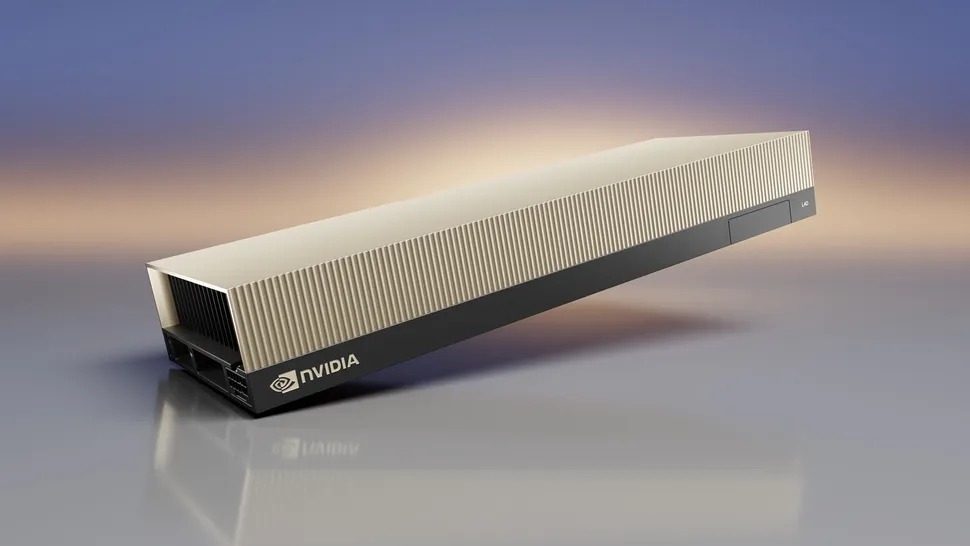Nvidia recently unveiled the new L40S data center GPU, positioned as a more affordable high-memory alternative to their premium H100 for AI development and inference workloads.
With performance nearing the H100 and 48GB of VRAM, the L40S caters to users wanting cutting-edge throughput without paying extreme H100 prices.
In this guide, we’ll examine the specs, capabilities, and pros and cons of the L40S versus the H100, including:
- Technical architectural overview
- Performance comparisons and benchmarks
- Memory configurations and caching
- NVLink and multi-GPU scaling
- AI development, training, inference uses
- Ray tracing and graphics capabilities
- Data analytics, HPC, and simulation performance
- Power efficiency and thermal management
- Target workloads and ideal users
- Practical considerations for integration
- Cost and value proposition compared to H100
- Positioning Nvidia’s enterprise GPU portfolio
For certain applications, the L40S presents an enticing option blending robustness and affordability. Let’s dig into the emerging “Goldilocks zone” the L40S aims to occupy for demanding enterprise computing.
Nvidia L40S Architecture and Specifications
Like H100, L40S leverages Nvidia’s cutting-edge Hopper architecture optimized for data center workloads. Key specifications:
- 84 Streaming Multiprocessors (SMs)
- 10,752 CUDA processing cores
- 48GB GDDR6X memory @ 21Gbps
- 75 teraflops FP8 compute performance
- 15 teraflops FP64 performance
- 300-watt TDP
- Full-height, full-length form factor
Core counts and clocks land between the H100 and previous gen A100, but memory size matches H100 capacities. PCIe Gen 5 provides abundant bandwidth.
Performance and Benchmarks Compared to Nvidia H100
Nvidia positioning implies L40S lags behind the flagship H100:
- Up to 30% slower training performance
- Up to 10% slower inference throughput
- GPU-Direct Storage speeds 20% behind H100
- Approximately 25% lower raw teraflop counts
But the L40S still represents roughly 2X performance gains over last-gen hardware. Benchmarks will reveal exact speeds across workloads.
L40S Features 48GB VRAM Matching H100 Capacities
One key advantage the L40S does hold over even the H100 is its generous 48GB pool of GDDR6X memory – on par with the top H100 SKU configuration.
The ample onboard VRAM enables handling large datasets and models beyond what current-gen hardware allows. This avoids costly data movement to system memory.
NVLink Support for Multi-GPU Scaling
Like all Nvidia data center GPUs, the L40S supports NVLink for pooling resources across multiple cards. Key advantages:
- Combine up to 4 L40S GPUs per node over NVLink
- Scale memory capacity and bandwidth with GPU counts
- NVLink bandwidth hits 1.6 TB/s
- Fast GPU-to-GPU direct data transfers
- Simplified GPU programming model
NVLink unlocks linear scaling of ConnectX-7 Infiniband and PCIe Gen 5. Multi-node configurations can drive 10x application speedups.
AI Development and Training Performance
The L40S excels at large batch sizes for AI development:
- Handles complex neural network model parallel training
- Optimized for large transformer-based models
- Leverages 4th gen Tensor Cores for up to 7x inference speedups
- Sparsity acceleration improves training throughput
- Integrated acceleration for PyTorch, TensorFlow, CUDA, and more
While slower than H100, the L40S still achieves rapid iteration cycles for large-scale AI research and deployment.
AI Inference for Recommendation and NLP Applications
The L40S also ships optimized for demanding real-time AI inferencing:
- Maximizes throughput of recommendation models
- Accelerates natural language processing (NLP) for chatbots and searches
- Speeds streaming video classification and effects
- Rapidly identifies anomalies in real-time data
- Fast inference for cloud gaming and rendering workloads
- Powers low-latency personalized user experiences
If prediction latency and cost efficiency matter more than maximizing absolute TCO, the L40S excels on inference affordably.
Professional Graphics and Ray Tracing
With its Ampere architecture, the L40S provides robust professional visualization capabilities:
- Supports Nvidia RTX for high-fidelity ray tracing
- Offers CUDA, OpenGL, Vulkan graphics APIs
- Drives up to 4 high-res displays per GPU
- Powers immersive VR applications
- Enhances visualization and remote collaboration
Mission-critical analytics, engineering, and design users can tap into L40S graphics for decision-making.
HPC, Data Analytics, and Simulation Workloads
The L40S accelerates parallel HPC, data analytics, and simulation workloads:
- Maximizes throughput of fluid, thermo, and structural mechanics modeling
- Speeds financial risk analytics leveraging CUDA and Python
- Enables huge genomic sequencing datasets
- Powers real-time analytics on streaming data lakes
- Trains physics-based autonomous vehicle models faster
- Crunches combinatorics optimizations for supply chain logistics
If crunching big data for insights drives ROI more than optimal cost efficiency, the L40S satisfies.
Power Efficiency and Thermal Design
The L40S sips a reasonable 300 watts TDP yet still delivers brute force:
- Nvidia claims up to ~30% better power efficiency over A100
- Leverages multi-chip module (MCM) design to reduce power needs
- Uses high-efficiency GDDR6X memory
- Features improved cooling technologies for heat dissipation
- Reduces CPU bottlenecking through direct GPU data transfers
- Lower TDP makes cooling more practical in data centers
While not as frugal as H100, the L40S balances muscle and efficiency.
Ideal L40S Target Users and Workloads
The L40S hits the sweet spot for a few profiles:
Compute-Intensive Commercial Departments
Scaling AI and HPC capabilities to internal teams without overspending.
Researchers and Academics
Obtaining leading-edge results and rapid iteration cycles on grants and limited funding.
Video Game and VFX Studios
Powering creative projects on tight budgets and rendering pipelines.
Cloud Service Providers
Making high-throughput GPU resources accessible to clients cost-effectively.
Independent Consultants
Leveraging robust hardware for client deliverables without steep personal investment.
For many professionals, the L40S strikes the right balance of affordability and capability.
Practical Deployment and Integration Considerations
To maximize the value of L40S cards in real-world environments, consider:
- Pairing with servers featuring large core counts, ample PCIe 5.0 lanes, and lots of system memory. Don’t bottleneck the cards.
- Using NVLink to combine multiple GPUs for additive capability as needed.
- Favoring CPU-GPU servers with unified memory architecture vs discrete configurations.
- Ensuring data pipelines, APIs, algorithms, and code are optimized to exploit L40S parallelism.
- Monitoring workloads to identify opportunities to scale up GPU resources on demand.
- Considering renting accelerated cloud instances for temporary burst capacity.
- Weighing benefits of on-premise deployment versus cloud offload for specific use cases.
- Exploring using containers and Kubernetes for abstraction and portability across systems.
Hardware is only one piece. Optimizing software and infrastructure unlocks the most value.
L40S Cost and Value Proposition Versus H100
With performance nearing H100 levels, the L40S offers compelling ROI:
- Roughly half the price of comparable H100 configurations.
- Matches H100 memory capacity for larger models and datasets.
- Outperforms last-gen hardware at similar price points.
- Saves substantially over previous-gen options while gaining generational performance leaps.
- Unlocks new applications not previously feasible on older GPUs.
- Shorter term TCO and faster breakeven than pricier H100.
- Makes massive inference clusters more attainable for commercial viability.
The L40S breaks new ground on delivering leading-edge throughput minus the flagship premium.
Positioning Within Nvidia’s Broader Data Center GPU Portfolio
The L40S adds a middle ground offering to Nvidia’s data center GPU lineup:
Nvidia H100 – No compromises top-tier offering for maximum performance to price.
Nvidia L40S – Balanced blend of affordability and capability.
Nvidia A100 – Proven workhorse GPU for mass deployment.
Nvidia A16 – Entry-level Ampere card for basic GPU augmentation.
Nvidia A2 – Cost-optimized inference focused on scale-out.
The layers cater across needs – L40S fills the gap between bleeding edge H100 and established A100/A16.
Conclusion
Nvidia’s new L40S GPU gives enterprises an intriguing middle option blending robust performance with greater cost efficiency versus the flagship but costly H100. For organizations without massive scale, the L40S unlocks ample AI, visualization, analytics, and HPC horsepower at moderate prices.
True, the H100 remains Nvidia’s pinnacle offering if budget is no concern. But the L40S fulfils an unmet craving for tapping into leading-edge throughput without overspending. By offering a spectrum of capabilities, Nvidia is transcending the one-size-fits all model to infiltrate new budgets and users.
For enterprises maximizing every dollar, thearrival of the L40S epitomizes how healthy competition breeds innovation across expanding niches. No singular solution reigns supreme when diverse needs reign supreme.










Add Comment